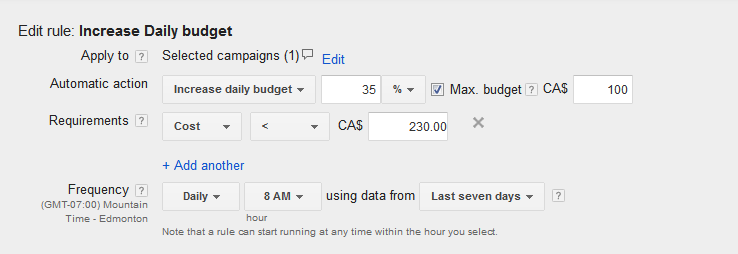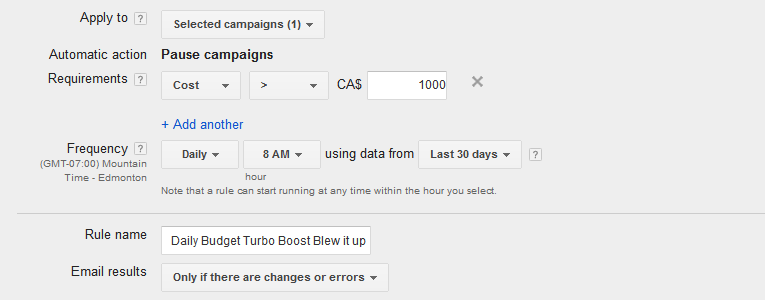1 Great Adwords Automated Rule To Manage Tricky Daily Budgets
It’s 12 noon on Wednesday, and I have approx 45 minutes to get a blog post on Google Adwords ready to go for Friday, prior to heading out on a glorious week of sun and fun. Time is of the essence!
Speaking of time management and Adwords, there are some pretty nifty ways to save precious minutes (and even hours) in your busy week by deploying some simple Adwords automated rules.
The Dilemma
For many accounts we deal with, we often run into an interesting catch-22: a daily budget and an average cpc that are effectively the same. In this scenario, any click on a given day is enough to turn the account off as it depletes the daily budget. The same could be said of an account that only allows for 2 clicks per day.(Pretty hard to dial something like this in, right?)
To make matters more interesting, we often find that in these types of accounts several days can go by without the account accruing a click; while on other days, it is possible to obtain two, three, or even four clicks in a single day.
Thus, we ultimately wind up with days where we have unused budget, and days where we need more budget.
This often means watching the account like a hawk, and making manual ‘daily’ budget changes that can be time consuming to say the least.
How Google Deals with These Issues at a Simple Level
The Adwords system has a way of dealing with these sorts of daily budget anomalies in their own way.
While many advertisers may not realize this, up to 20% of your campaign’s daily budget can be used to show your ads on certain days of the week or certain times of the month based on fluctuations in traffic. It’s important to note that Adwords will never go over the monthly budget you have set.
Issues with Google’s Simple Budget Balancing
Standard delivery doesn’t allow for delivery optimization (and you aren’t left with much control over when your ads are showing) and Google’s budget balancing doesn’t let you pick when your budget goes over.
Alternatively, accelerated delivery allows the use of bid modification along with ad scheduling to show ads when you want to show them based on your budget.
By writing aggressive (and strategic) budget rules, we can create daily budget variations much higher than Google’s 20% default, and give your daily budget a major bump when needed.
Daily Budget Turbo Boost:
So the ‘rule’ itself is actually a combination of three rules. This super-rule we’ve concocted allows for much more aggressive daily budget management.
Logic:
- Take the client’s monthly budget and divide by 4. Use this as the premise of a ‘weekly’ budget.
- Every day, look back at the last 7 days. Did we use all the budget?
- If we were UNDER budget, increase the daily budget by x%
- If we went OVER budget, decrease the daily budget by x%
- If we have used ALL the clients MONTHLY budget
- Send me an email letting me know we’ve depleted the monthly budget, and/or;
- Pause the account
The rule below is an example of this. The client has a $1000/m budget, and we’re breaking that down as a $230 ‘weekly’ budget ($1000 / 4.34 weeks in a month = $230).
You can see above that every day bright and early at 8 am while the Googlebot enjoys a piping hot soy vanilla latte we’re asking it to look back over the last 7 days. If this account hasn’t spent $230 in the last week, we want the Googlebot to increase the daily budget by 35%. We’re also adding a very important limit here, requiring that it not take the daily budget over $100.
Similarly, above we’re asking Google to do the reverse – If the account has spent more than $230 in the last 7 days, decrease the daily budget by 35%, but do not reduce to less than $35/day.
Finally, we’ve got a rule that runs daily that looks back over the last 30 days. Here, we want to have the campaign paused, and be notified via email if our set of rules has taken the account over our actual monthly budget.
To this end, we’ve created a few variations on this as well.
For example, a rule could be set to notify you:
- when you are at 90% of your monthly budget (If you’re getting this 2 weeks into the month, your budgets are running too hot!)
- if the daily budget has been ‘pinned’ to it’s max or minimum budget for more than ‘x’ days
These sorts of rules and notifications alert you that manual intervention is required, and most likely some fine tuning to the rules themselves.
Disclaimer
As you can imagine, the percentage by which you allow the rule to change the budget and the limits you implement can have a pretty dramatic effect on an account.
Before you start rolling out scripts like this, I suggest you have at least 30-60 days of data (if not more) to manually observe how the account performs. It’s important to make the aforementioned ‘manual’ budget changes – noting days of week, keyword themes, and other segments that seem to most affect cost before you start to implement any rules.
In practice, we’ve seen these rules work well on most ‘daily budget cursed accounts’, but on others these simple budget adjustments seem to take the account to it’s upper / lower limits and stay there. Boo!
Conclusion
In short, the basic premise of this set of daily budget rules is to ensure your daily budget can swell up to meet demand on days you need it, all the while letting you know if things are getting out of hand.
I would encourage you to experiment with this concept, while editing to meet the individual accounts needs.
Have you own tips to share for managing tough daily budgets? Feel free to share in the comments!


